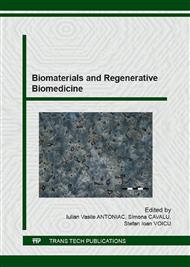[1]
Winquist R.A., Locked Femoral Nailing, J Am Acad Orthop Surg, 1: 2 (1993), 95-105.
Google Scholar
[2]
Goodwin R., Mahar A.T., Oka R., Steinman S., Newton P.O., Biomechanical evaluation of retrograde intramedullary stabilization for femoral fractures: the effect of fracture level, J Pediatr Orthop, 27: 8 (2007), 873-876.
DOI: 10.1097/bpo.0b013e31815b12df
Google Scholar
[3]
Ricci WM, Gallagher B, Haidukewych GJ., Intramedullary nailing of femoral shaft fractures: current concepts, J Am Acad Orthop Surg, 17: 5 (2009), 296-305.
DOI: 10.5435/00124635-200905000-00004
Google Scholar
[4]
Winquist RA, Hansen ST Jr, Clawson DK, Closed intramedullary nailing of femoral fractures. A report of five hundred and twenty cases, J Bone Joint Surg Am, 83-A12 (2001), (1912).
DOI: 10.2106/00004623-200112000-00021
Google Scholar
[5]
Momberger N, Stevens P, Smith J, et al., Intramedullary nailing of femoral fractures in adolescents, J Pediatr Orthop, 20: 4 (2000), 482-484.
DOI: 10.1097/01241398-200007000-00011
Google Scholar
[6]
Ghiban B., Metallic Biomaterials, Publisher Printech, Bucharest (1999), 20-30.
Google Scholar
[7]
Niculescu M, Laptoiu D, Miculescu F, Antoniac I, Biomaterials view on the complications associated with hip resurfacing arthroplasty, Advanced Materials Research, 1114 (2015), 247-252.
DOI: 10.4028/www.scientific.net/amr.1114.247
Google Scholar
[8]
Ghiban B., Mechanical and corrosion behaviour of some devices for ostheosinthesis, Advanced Materials Research, 23 (2007), 257-260.
DOI: 10.4028/www.scientific.net/amr.23.257
Google Scholar
[9]
Niculescu M, Laptoiu D, Miculescu F, Antoniac I, Metal allergy and other adverse reactions in patients with total hip replacement, Advanced Materials Research, 1114 (2015), 283-287.
DOI: 10.4028/www.scientific.net/amr.1114.283
Google Scholar
[10]
Ionescu R, Mardare M, Dorobantu A, Vermesan S, Marinescu E, Saban R, Antoniac I, Ciocan D.N., Ceausu M., Correlation between materials, design and clinical issues in the case of associated use of different stainless steels as implant materials, KEM, 583 (2014).
DOI: 10.4028/www.scientific.net/kem.583.41
Google Scholar
[11]
Razvan I, Iulian A, Cosmin C, Florin M, Eugeniu V, Munteanu C, Moldan D, Marius N, Potential solutions to increase the corrosion resistance of metallic surgical instruments using different types of ceramic coatings, KEM, 614 (2014), 206-211.
DOI: 10.4028/www.scientific.net/kem.614.206
Google Scholar
[12]
Ionescu R; Cristescu I; Dinu M; Saban R; Antoniac I; Vilcioiu D; Clinical, biomechanical and biomaterials approach in the case of fracture repair using different systems type plate-screw, KEM, 583 (2014), 150-154.
DOI: 10.4028/www.scientific.net/kem.583.150
Google Scholar
[13]
Azevedo C.R.F., Hippert Jr.E., Failure Analysis of Surgical Implants in Brazil, J. Eng. Failure Analys., 9 (2002), 621-633.
DOI: 10.1016/s1350-6307(02)00026-2
Google Scholar
[14]
Cristescu I; Antoniac I; Vilcioiu D; Safta F; Analysis of centromedullary nailing with implant failure, KEM, 638 (2015), 130-134.
DOI: 10.4028/www.scientific.net/kem.638.130
Google Scholar
[15]
Edwin M.M., Edward V.A., Peter J.S., Neal J.S., Exchange Nailing for Failure of Initially Rodded Tibial Shaft Fractures, J. Orthop., 24: 8 (2001), 757-762.
DOI: 10.3928/0147-7447-20010801-17
Google Scholar
[16]
Bane M; Miculescu F; Blajan AI; Dinu M; Antoniac I; Failure analysis of some retrieved orthopedic implants based on materials characterization, Solid State Phenomena, 188 (2012), 114-117.
DOI: 10.4028/www.scientific.net/ssp.188.114
Google Scholar
[17]
Christian G., Stefanie S., et al., Implant Failure of the Gamma Nail, Injury, Int. J. Care Injured, 30 (1999), 91-99.
Google Scholar
[18]
Wall E. J., Jain V., Vora V., Mehlman C. T, Crawford A.H., Complications of Titanium and Stainless Steel Elastic Nail Fixation of Pediatric Femoral Fractures, J Bone Joint Surg. Am, 90: 6 (2008), 1305-1313.
DOI: 10.2106/jbjs.g.00328
Google Scholar


